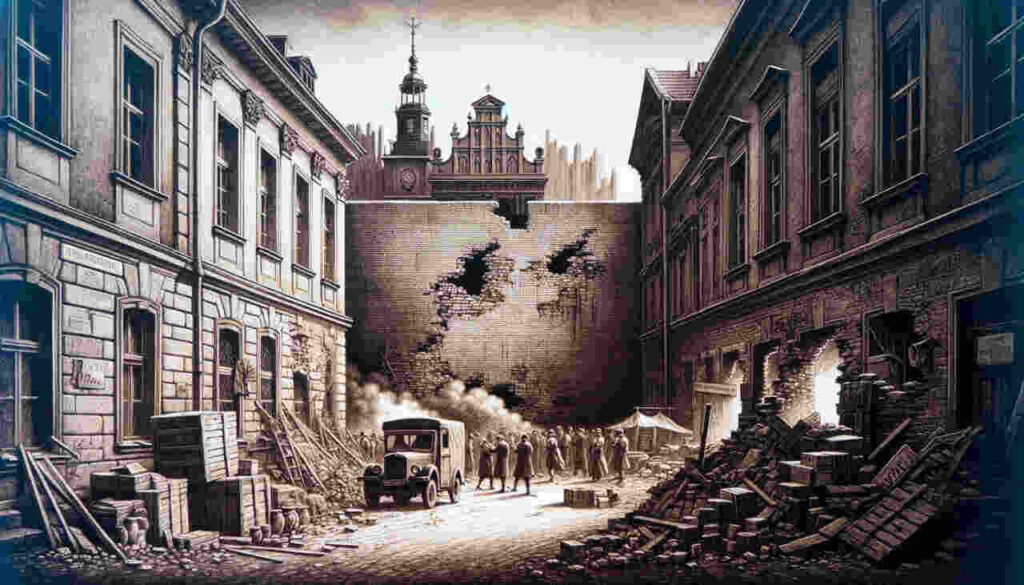On this day, the Jewish Resistance in the Warsaw Ghetto Uprising was crushed by the Nazi regime. This was a resistance movement organized by the Jews of Warsaw in a desperate attempt to stop the Nazis from exterminating the Jewish inhabitants of the city. Despite being badly outnumbered and having only a handful of weapons, the Jews bravely resisted their Nazi occupiers. Although they failed to stop the Nazis, it sent a message across the world that the Jewish people and those in occupied Europe would not quietly go to the slaughter.
Jewish Resistance Defiance
When Poland was conquered by Nazi Germany, they created a ghetto within Warsaw in order control the Jewish population. By 1943, conditions in the ghetto had deteriorated severely, with starvation, disease, and constant terror inflicted by the Nazis.
This became such a big issue across all of Europe that the Nazis eventually decided to liquidate the Jewish population in an act of ethnic cleansing called the Final Solution. The Warsaw ghetto was no different and began in January 1943. All across Europe news of mass deportations to extermination camps like Treblinka spread.
The Jews in the Warsaw ghetto realized that they would face a similar fate and decided to try and drive the Germans out. Two resistance groups, the Jewish Combat Organization (ŻOB) and the Jewish Military Union (ŻZW) formed in defiance of the Nazi regime.
They gathered a small arsenal of weapons, including pistols, rifles, and homemade explosives. Despite their limited resources, the fighters were determined to make a stand.
The uprising officially began on April 19, 1943, the eve of Passover, when Nazi forces, led by SS General Jürgen Stroop, entered the ghetto to commence its final liquidation. The Jewish fighters launched a coordinated attack, surprising the German troops and forcing them to retreat.
Over the next few weeks, fierce and desperate fighting ensued. The ghetto fighters employed guerrilla tactics, utilizing the ruins and underground bunkers for cover.
The Nazis, however, responded with overwhelming firepower and brutality. They systematically destroyed the ghetto, setting buildings on fire and massacring the population in retaliation. Despite these dire conditions, the Jewish fighters held out for nearly a month.
The Warsaw Ghetto Uprising

The Warsaw Ghetto Uprising reached its tragic conclusion on May 16, 1943, when SS General Jürgen Stroop reported to his superiors the complete destruction of the ghetto. Stroop’s chilling report, titled “The Warsaw Ghetto is No More,” detailed the systematic annihilation of the ghetto and the ruthless suppression of the Jewish resistance.
The final blow came with the demolition of the Great Synagogue of Warsaw on Tłomackie Street. General Stroop personally ordered its destruction as a symbolic gesture to mark the end of Jewish resistance. The synagogue, a significant cultural and religious symbol for the Jewish community, was blown up on May 16, serving as a grim exclamation point to the brutal campaign.
Despite their extraordinary bravery, most of the Jewish fighters perished in the conflict. Those who were not killed in the fighting were captured and sent to concentration camps, where many faced immediate execution or succumbed to the horrific conditions. The few survivors who managed to escape the ghetto continued their resistance in various forms, joining partisan groups or aiding underground movements.
The aftermath of the uprising left the Warsaw Ghetto in ruins. The Nazis methodically destroyed buildings, block by block, using heavy artillery, flamethrowers, and explosives. The ghetto, once home to hundreds of thousands of Jews, was reduced to rubble, with only a few structures left standing amid the devastation.
If you want to create vintage letters that look fit for the queen, our Vintage Letter platform can let you create some beautiful letters that you can try here.

Pingback: Lascaux Cave Letters Reveals A 17,000-Year-Old Secret
Comments are closed.